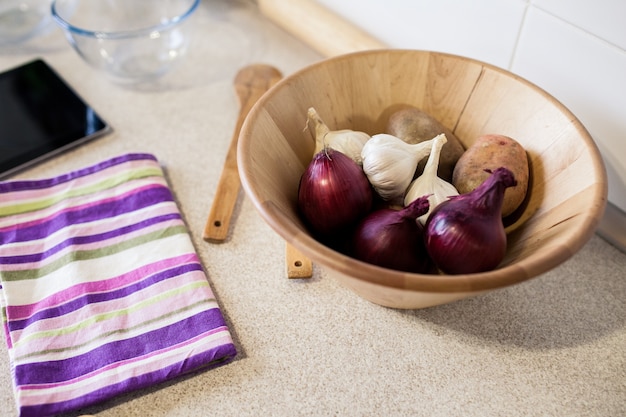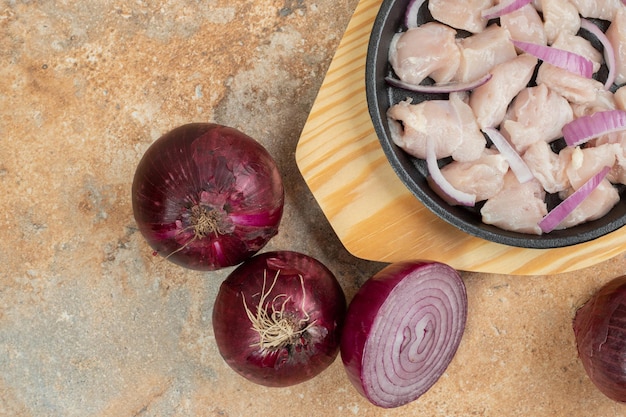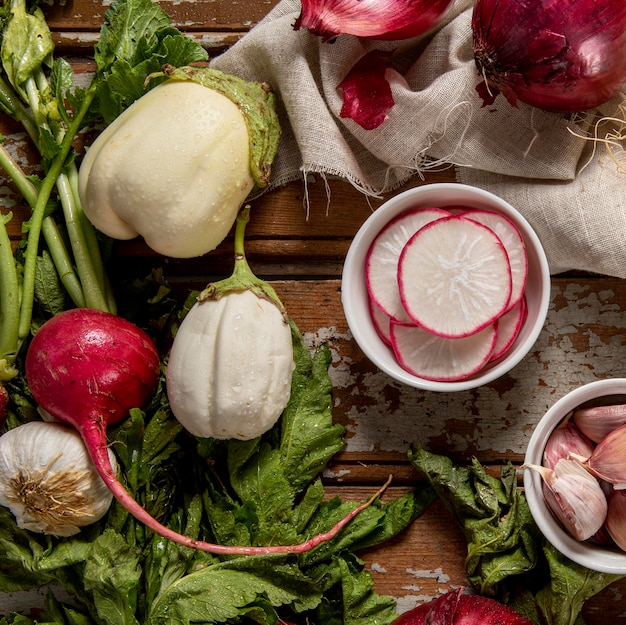Oh, beets. Those earthy, vibrant root vegetables that can be both intimidating and utterly delicious. For years, I avoided them, put off by the vibrant crimson juice staining everything in sight. But then, a friend introduced me to the joys of roasted beets, and my world changed. Since then, I've been on a beet-loving mission, exploring all sorts of recipes, from simple salads to hearty stews. And let me tell you, there's a whole world of flavour waiting to be discovered in this humble root. So, grab your apron, my fellow food enthusiasts, because we're about to embark on a beet-tastic journey together. We'll dive deep into understanding these fascinating vegetables, explore various cooking methods, and unearth a treasure trove of beet recipes that will tantalize your taste buds and leave you wanting more.
(Part 1) Understanding the Beet

What Makes a Beet, a Beet?
Let's start with the basics. Beets are a root vegetable, meaning we eat their bulbous root, which grows underground. They're members of the Amaranthaceae family, which also includes spinach and quinoa. They come in a variety of colours, from the classic deep crimson to golden yellow and even striped. Their flavour is earthy and sweet, with a slightly bitter note depending on the variety. This is what makes them so versatile in the kitchen – they can hold their own in salads, lend depth to soups, and even star in desserts.
The History of Beets: A Global Journey
Beets have a rich history, dating back thousands of years. Originating in the Mediterranean region, they were cultivated by ancient Egyptians, Greeks, and Romans. They eventually spread to other parts of Europe, Asia, and eventually, to the Americas. Interestingly, beets weren't initially grown for their roots; the ancient Greeks used the leaves for medicinal purposes and as a leafy green in their cuisine. It wasn't until the 19th century that beets became popular as a root vegetable in Western Europe, particularly in Germany. Today, beets are enjoyed around the world, and their popularity continues to rise as people discover their versatility and nutritional benefits.
Picking the Perfect Beet
When choosing your beets, look for firm, smooth roots with a good weight for their size. Avoid any with soft spots, cracks, or signs of rot. Don't be afraid to choose smaller beets – they tend to be more tender. And keep in mind, colour doesn't necessarily indicate flavour. A paler beet can be just as delicious as a deep crimson one. Beets can be found in most grocery stores year-round, but they are typically in season from late spring to early fall.
Storing Your Beets
Once you've brought your beets home, store them in a cool, dark place, like your fridge's vegetable drawer. They can last for up to 3 weeks this way. However, for the best flavour and texture, use them within a week or two. beet greens, on the other hand, should be stored separately in a plastic bag in the refrigerator and used within a few days.
(Part 2) Prepping the Beet

Before we dive into the world of beet recipes, let's talk about prepping these root vegetables. It's a simple process, but it makes a world of difference in the final dish.
Washing and Trimming
First, give your beets a good wash under cold running water to remove any dirt or grit. Then, trim off the leafy greens, leaving about an inch of stem attached. This helps keep the beets moist and prevents them from drying out. If you're planning on using the greens in a recipe, be sure to wash them separately. Remember, the leaves of beets are edible and can be used in salads, soups, or sautéed like spinach.
The Great Debate: To Peel or Not to Peel
This is a question that has divided beet lovers for generations. Some swear by peeling their beets, claiming it makes them easier to chop and avoids any tough, fibrous bits. Others prefer to roast or bake them with the skin on, then simply slip it off after cooking. This method retains more nutrients and adds a subtle earthy flavour. Personally, I'm a fan of the no-peel approach, especially when roasting or grilling. The skin softens and adds a lovely caramelized flavour to the beet. But, ultimately, the choice is yours. If you do decide to peel, it's best to do it after cooking, as the skin will come off more easily.
(Part 3) cooking techniques for the Perfect Beet

Now, for the fun part: cooking! Beets can be prepared in several ways, each yielding a unique flavour and texture.
Roasting for Sweet, Tender Goodness
Roasting is my go-to method for beets. It brings out their natural sweetness and creates a tender, melt-in-your-mouth texture. Simply preheat your oven to 400°F (200°C), toss the beets with a drizzle of olive oil, salt, and pepper, and roast for 45-60 minutes, or until tender. You can wrap them in foil for a more even cook, but I find that roasting them uncovered yields a slightly caramelized exterior. The roasting time will vary depending on the size of the beets. Smaller beets may only need 30-45 minutes.
Boiling for a Classic Approach
If you prefer a quicker method, boiling is a classic way to cook beets. Bring a large pot of salted water to a boil, add the beets, and simmer for 30-45 minutes, or until tender. Then, drain the water and let the beets cool slightly before peeling. Boiling is a good option if you are short on time, but it can result in a slightly less flavorful beet.
Grilling for Smoky Flavour
For a smoky, charred flavour, try grilling your beets. Preheat your grill to medium heat, brush the beets with olive oil, and grill for 15-20 minutes, turning occasionally, until tender. The grill marks add a lovely aesthetic touch, too. Grilling beets is a great way to add a smoky depth to their flavour. Be sure to watch them closely, as they can burn easily.
Microwaving for Speedy Meals
In a pinch, you can also microwave your beets. Wrap them in a damp paper towel, microwave on high for 5-7 minutes, or until tender. The microwave method is great for smaller beets, but it might not yield the same depth of flavour as roasting or grilling. Microwaving is the fastest method, but it may result in a slightly mushy texture.
Tips for Perfect Beet Cooking:
- Don't overcook beets. They should be tender but not mushy.
- Add a splash of vinegar to the boiling water to help retain their color.
- For a sweeter flavor, roast beets with a little honey or maple syrup.
- Store leftover cooked beets in the refrigerator for up to 4 days.
(Part 4) Beet Recipes for Every Occasion
Now that you've got the basics down, let's delve into some delicious beet recipes. From simple salads to hearty stews, these recipes showcase the versatility of this humble root.
(Part 4.1) beet salads: A Burst of Freshness
Beets are a natural addition to salads, providing a vibrant colour and earthy sweetness. Here are a few of my favourite beet salad combinations:
Beet and Goat Cheese Salad with Candied Walnuts
This salad is a symphony of textures and flavours. The creamy goat cheese contrasts beautifully with the sweet, earthy beets, and the candied walnuts add a delightful crunch. It's a simple salad that's sure to impress.
- 1 pound roasted beets, diced
- 4 ounces goat cheese, crumbled
- 1/2 cup candied walnuts, chopped
- 1/4 cup chopped fresh parsley
- 1/4 cup balsamic vinaigrette
Beet and Citrus Salad with Feta Cheese
This refreshing salad combines the sweetness of beets with the tanginess of citrus and the salty bite of feta cheese. It's a perfect light lunch or side dish for a summer barbecue.
- 1 pound roasted beets, diced
- 1 orange, segmented
- 1/2 cup crumbled feta cheese
- 1/4 cup chopped fresh mint
- 1/4 cup olive oil
- 1 tablespoon lemon juice
- Salt and pepper to taste
Beet and quinoa salad with Lemon-Dill Dressing
This salad is a hearty and healthy option. Quinoa adds protein and fiber, while the lemon-dill dressing provides a bright, refreshing flavour. It's a great way to enjoy beets as a main course.
- 1 cup cooked quinoa
- 1 pound roasted beets, diced
- 1/2 cup chopped red onion
- 1/4 cup chopped fresh dill
- 1/4 cup lemon juice
- 1/4 cup olive oil
- Salt and pepper to taste
(Part 4.2) Beet Soup: Warm and Comforting
Beets are a natural ingredient for hearty and flavourful soups. Their earthy sweetness blends beautifully with other vegetables and herbs. Here are a few recipes to try:
Roasted Beet and carrot soup with Ginger
This soup is a delightful combination of sweet, earthy flavours. The ginger adds a warming kick, making it perfect for a chilly day.
- 1 pound roasted beets, diced
- 1 pound roasted carrots, diced
- 1 tablespoon fresh ginger, minced
- 4 cups vegetable broth
- Salt and pepper to taste
- 1/4 cup heavy cream or coconut milk (optional)
Beet and lentil soup with Lemon and Mint
This soup is packed with protein and fiber, making it a satisfying and nutritious meal. The lemon and mint add a bright, refreshing flavour that cuts through the earthiness of the beets and lentils.
- 1 pound roasted beets, diced
- 1 cup dried green lentils
- 4 cups vegetable broth
- 1 onion, chopped
- 2 cloves garlic, minced
- 1/4 cup chopped fresh mint
- 1/4 cup lemon juice
- Salt and pepper to taste
(Part 4.3) beet burgers: A Hearty Delight
Who needs beef when you have beets? These veggie burgers are packed with flavour and nutrition, and they're surprisingly satisfying.
Black Bean and Beet Burgers with Avocado Cream
These burgers are a great source of protein and fiber. The avocado cream adds a creamy richness that complements the earthy sweetness of the beets.
- 1 cup cooked black beans, mashed
- 1 cup roasted beets, shredded
- 1/2 cup bread crumbs
- 1/4 cup chopped onion
- 1 egg, beaten
- 1 tablespoon olive oil
- Salt and pepper to taste
- 1 ripe avocado, mashed
- 1 tablespoon lime juice
- Salt and pepper to taste
(Part 4.4) beet hummus: A Healthy Dip
Hummus is a versatile dip that can be enjoyed with crackers, pita bread, or even as a spread for sandwiches. Adding beets gives it a vibrant colour and sweet, earthy flavour.
Roasted Beet Hummus with Tahini
This hummus is a creamy and flavourful dip. The tahini adds a nutty richness, while the roasted beets provide a sweet, earthy flavour.
- 1 cup cooked chickpeas
- 1 cup roasted beets, diced
- 1/4 cup tahini
- 1/4 cup lemon juice
- 2 cloves garlic, minced
- 1/4 cup olive oil
- Salt and pepper to taste
(Part 4.5) Beet Relish: A Tangy Treat
A beet relish is a delightful condiment that adds a burst of colour and flavour to any dish. It can be used as a topping for sandwiches, burgers, or even grilled fish.
Quick Beet Relish with Horseradish
This relish is quick and easy to make, and it's a perfect way to use up leftover roasted beets. The horseradish adds a spicy kick that complements the sweet, earthy flavour of the beets.
- 1 cup roasted beets, diced
- 1/4 cup chopped red onion
- 1 tablespoon prepared horseradish
- 1 tablespoon apple cider vinegar
- Salt and pepper to taste
(Part 5) Beet Desserts: Sweet Surprises
Yes, you read that right! Beets can even make their way into desserts, adding a unique earthy sweetness to cakes, cookies, and brownies.
(Part 5.1) Beet Brownies: A Rich and Fudgy Treat
Don't knock it till you try it! Beet brownies are incredibly rich and fudgy, with a slight earthy sweetness that complements the chocolate perfectly.
Chocolate Beet Brownies with chocolate ganache
These brownies are a decadent treat that's sure to impress. The chocolate ganache adds a luxurious touch, while the beets provide a subtle earthy flavour.
- 1 cup roasted beets, pureed
- 1 cup unsweetened cocoa powder
- 1 cup sugar
- 1/2 cup butter, melted
- 2 eggs
- 1 teaspoon vanilla extract
- 1/2 cup semisweet chocolate chips
- 1/2 cup heavy cream
(Part 5.2) Beet Cake: A Vibrant and Delicious Treat
A beet cake might sound unusual, but it's actually a delightful surprise. The beets add a subtle sweetness and moisture to the cake, creating a tender and flavorful treat.
Red Velvet Beet Cake with cream cheese frosting
This cake is a classic red velvet cake with a beet twist. The beets add a vibrant red hue and a slight earthy flavour that complements the cream cheese frosting perfectly.
- 1 cup roasted beets, pureed
- 2 cups all-purpose flour
- 1 teaspoon baking soda
- 1/2 teaspoon salt
- 1 cup sugar
- 1/2 cup butter, softened
- 2 eggs
- 1 teaspoon vanilla extract
- 1 cup buttermilk
- 1 cup powdered sugar
- 1/4 cup butter, softened
- 8 ounces cream cheese, softened
- 1 teaspoon vanilla extract
(Part 6) beet juice: A Health Boost
Beet juice is a popular choice for its health benefits. It's packed with antioxidants, nitrates, and other nutrients that can improve blood flow, boost athletic performance, and even lower blood pressure.
Making Your Own Beet Juice
Making beet juice at home is surprisingly easy. You can use a juicer or a blender. If using a blender, simply puree the beets with a little water, then strain the juice through a cheesecloth. You can add other fruits and vegetables, like carrots, apples, or ginger, to create a more flavorful and balanced juice.
Tips for Enjoying Beet Juice
Beet juice can be quite potent, so start with a small amount and gradually increase the quantity as you get used to the taste. You can dilute it with water or mix it with other juices. To reduce the earthy taste, add a squeeze of lemon or lime juice. For a sweeter taste, add a few drops of stevia or honey. Adding a pinch of salt can also enhance the flavour.
Health Benefits of Beet Juice
Beet juice is a nutrient-rich beverage that offers various health benefits, including:
- Improved Blood Flow: Beets contain nitrates, which are converted to nitric oxide in the body. Nitric oxide helps dilate blood vessels, improving blood flow and lowering blood pressure.
- Enhanced Athletic Performance: Beet juice can improve athletic performance by increasing endurance and reducing fatigue. Nitrates may also increase oxygen uptake, leading to greater efficiency during exercise.
- Antioxidant Properties: Beets are rich in antioxidants, which protect cells from damage caused by free radicals. Antioxidants may help reduce the risk of chronic diseases like cancer and heart disease.
- Improved Liver Function: Beets contain betaine, a nutrient that supports liver function and detoxification.
- Support for Digestive Health: Beets are high in fiber, which promotes digestive health and regularity.
(Part 7) FAQs
Still have questions about beets? Don't worry, I've got you covered!
1. What's the best way to store beets?
Store beets in a cool, dark place, like your fridge's vegetable drawer. They can last for up to 3 weeks this way.
2. How do I get the beet stain out of my hands?
Beet juice can leave a stubborn stain, but don't fret! Simply rub lemon juice or vinegar on the stained area, let it sit for a few minutes, then wash your hands with soap and water. You can also try soaking your hands in a mixture of baking soda and water.
3. Are beet greens edible?
Absolutely! Beet greens are packed with nutrients and have a slightly earthy, spinach-like flavour. You can use them in salads, stir-fries, or even sauté them with garlic and olive oil. Beet greens are a good source of vitamins A, C, and K, as well as iron and folate.
4. What are the health benefits of beets?
Beets are a nutritional powerhouse! They're packed with antioxidants, nitrates, and other nutrients that can improve blood flow, boost athletic performance, and even lower blood pressure. They are also a good source of fiber, folate, and potassium.
5. Can I freeze beets?
Yes, you can freeze beets. Simply blanch them in boiling water for a few minutes, then drain and cool them before freezing. Frozen beets can be used in soups, stews, or smoothies. Be sure to use frozen beets within 6-12 months for the best quality.
(Part 8) Beets: A culinary adventure Awaits
And there you have it! A beet-tastic journey through the world of these vibrant, earthy root vegetables. Remember, cooking with beets is a culinary adventure. Don't be afraid to experiment, get creative, and discover new ways to enjoy this versatile ingredient. So, put on your apron, grab some beets, and let your imagination run wild!
Everyone is watching

Prime Rib Roast Cooking Time Chart: Per Pound Guide
Cooking TipsPrime rib roast. Just the name conjures images of lavish dinners, crackling fires, and hearty laughter. It’s ...

How Long to Bake Potatoes in the Oven (Perfect Every Time)
Cooking TipsBaked potatoes are a staple in my kitchen. They're incredibly versatile, delicious, and surprisingly easy to m...

Perfect Rice Every Time: The Ultimate Guide to Cooking Rice
Cooking TipsAs a self-proclaimed foodie, I've always been a bit obsessed with rice. It's the foundation of countless cuisi...

The Ultimate Guide to Cooking Asparagus: Tips, Techniques, and Recipes
Cooking TipsAsparagus. The mere mention of this spring delicacy conjures up images of vibrant green spears, crisp and burs...

Ultimate Guide to Cooking the Perfect Thanksgiving Turkey
Cooking TipsThanksgiving. Just the word conjures up images of overflowing tables laden with delicious food, the scent of r...
